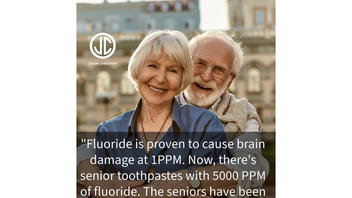
Does proof exist that fluoride toothpaste causes brain damage in adults? No, that's not true: The amount of fluoride consumed when brushing teeth, even with a high-fluoride toothpaste, is far below the toxic levels cited by Centers for Disease Control and Prevention guidelines. A study from that agency that reported the death of rodents exposed to fluoride referred only to inhaling high levels of fluoride as a gas, not to using it as a toothpaste.
The claim appeared in a post of an image (archived here) on Instagram on March 2, 2024. The image contained a quote that read:
'Fluoride is proven to cause brain
damage at 1PPM. Now, there is
senior toothpastes with 5000 PPM
of fluoride...'
The quote was attributed to "Jason Christoff," whose name appears in the account name.
This is what the post looked like on Instagram at the time of writing:
(Source: Instagram screenshot taken on Fri Mar 8 15:36:40 2024 UTC)
"Jason Christoff" is a self-proclaimed coach whose website omits (archived here) information about any educational background and formal training in medicine he may have had. As reported by The Guardian (archived here) in 2021, "Christoff" has been sharing conspiracies and COVID-related misinformation since at least 2020.
A toxicological profile on fluoride and a related group of chemical elements (archived here) from the Centers for Disease Control and Prevention (CDC), discusses deaths in rodents exposed to extremely high concentrations of fluoride. But these deaths occurred when the rodents inhaled fluoride as hydrogen-fluoride gas. The same report discussed the death of a human that occurred due to accidental exposure to a liquid form of hydrogen fluoride in a laboratory setting.
Toothpaste, however, is not a gas or a liquid acid. The CDC report, therefore, does not substantiate the claim on Instagram.
A fact sheet for health professionals (archived here) on the website of the National Institutes of Health specifically addresses exposure to fluoride through toothpaste:
Most toothpaste sold in the United States contains fluoride in the form of sodium fluoride or monofluorophosphate, most commonly at a level of 1,000 to 1,100 mg/L (about 1.3 mg in a quarter teaspoon, a typical amount of toothpaste used for one brushing). The amount of fluoride ingested from toothpaste depends on the amount used, the person's swallowing control, and how often the person uses toothpaste. Estimated typical amounts of fluoride ingested daily from toothpaste are 0.1 mg to 0.25 mg for infants and children age 0 to 5 years, 0.2 to 0.3 mg for children age 6-12 years, and 0.1 mg for adults.
The American Dental Association, a national professional organization, states (archived here) that high-fluoride toothpaste -- up to 5,000 ppm or parts per million -- is typically available only with a prescription. Use of high-fluoride toothpaste would lead to an estimated level of daily fluoride exposure of 0.5 milligrams for adults -- far below the toxic levels specified by the CDC.
The CDC's toxicological profile (archived here) for fluoride estimates (on page 74) the toxic level at between 32 and 64 milligrams per kilogram of adult body weight. Assuming that a person follows directions and does not swallow toothpaste, consuming anywhere close to this concentration by just brushing the teeth is virtually impossible.
While both the ADA (archived here) and the CDC (archived here) generally recommend fluoride toothpaste to prevent tooth decay, the 5,000 ppm concentration is not meant for general use. Both a 2019 review (archived here) of related studies and the ADA (archived here) have specified that 5,000 ppm fluoride toothpaste is for use in adults who are "high caries‐risk patients" or who already have root decay.
Lead Stories previously has debunked multiple false claims about fluoride.
















